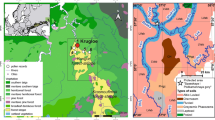Abstract.
The western Ordos plateau in the central-north of China is abundant in relic shrub species. Totally 54 shrub species belonging to 31 genera in 16 families are found in 10 desert shrub communities,including 10 local endemic species, five relic shrub species, and seven threatened species defined by the China Red Data Book. The percentage of the threatened shrub species to the total is as high as 12.9%, much greater than the national average (3.5%). Although a National Natural Reserve has been established since 1998 in the western Ordos plateau, the exploitation of mining resources continues to expand at a significant biological cost. Given the circumstances, future conservation efforts should focus on (1) removing coking and cement facilities from the reserve; (2) defining the boundaries of the Western Ordos National Natural Reserve encompassing all habitats where these shrub species occur; (3) implementing comprehensive plans coupling conservation with economic development; (4) enforcing ecological restoration after mining; and (5)␣establishing comprehensive population monitoring systems and promoting ex situ conservation. In addition, two local endemic relic species (Tetraena mongolica and Helianthemum ordosicum), which were defined as rare species in the second conservation priority by the China Red Data Book, should be considered as endangered species in the first conservation priority rank due to the extremely restricted distribution ranges, extremely scarce populations and more prominently, the currently increasing human disturbances caused by mining and urbanization in the core conservation area of the western Ordos plateau.
Similar content being viewed by others
References
J. Berger (2003) ArticleTitleIs it acceptable to let a species go extinct in a national park? Conservation Biology 17 1451–1454 Occurrence Handle10.1046/j.1523-1739.2003.02467.x
E.M. Bruna W.J. Kress (2002) ArticleTitleHabitat fragmentation and the demographic structure of an Amazonian understory herb Conservation Biology 16 1256–1266 Occurrence Handle10.1046/j.1523-1739.2002.99494.x
R. Cao F. Duan H. Ma S. Yong Y. Zhao (2001) ArticleTitleComparative study on physiological ecological characteristics between two relic plants: Helianthemum soongoricumTetraena mongolica Acta Botanica Boreali Occidentalia Sinica 21 184–187
InstitutionalAuthorNameCompilation Group (1998) China's Biodiversity: A Country Study (in Chinese) China Environmental Science Press Beijing
Cronquist A. 1968. Evolution and classification of flowering plants. Houghton Mifflin, Boston.
B.J. Darby B.D. Ritts (2002) ArticleTitleMesozoic contractional deformation in the middle of the Asian tectonic collage: the intraplate Western Ordos fold-thrust beltChina Earth and Planetary Science Letters 205 13–24 Occurrence Handle10.1016/S0012-821X(02)01026-9
A.K. David (1998) ArticleTitleAn evaluation and modification of World Conservation Union Red List criteria for classification of extinction risk in vascular plants Conservation Biology 12 1076–1090 Occurrence Handle10.1046/j.1523-1739.1998.97202.x
InstitutionalAuthorNameEditorial Committee for Vegetation of China (1980) Vegetation of China Science Press Beijing
L.K. Fu (1992) China Plant Red Data Book Science Press Beijing, China
Good R. 1974. The geography of the flowering plants. 4th ed, London.
E.S. Jules (1998) ArticleTitleHabitat fragmentation and demographic change for a common plant: Trillium in old-growth forest fragments Ecology 79 1645–1656
X.R. Li (2001) ArticleTitleStudy on shrub community diversity of the Ordos PlateauInner MongoliaNorthern China Journal of Arid Environments 47 271–279 Occurrence Handle10.1006/jare.2000.0707
G. Liu (1998) ArticleTitleStudy on the endangered reasons of Ammopiptanthus mongolicus in the desert of Alashan Bulletin of Botanical Research 18 341–345
J. Liu Z. Ouyang S.L. Pimm P.H. Raven X. Wang H. Miao N. Han (2003) ArticleTitleProtecting China's Biodiversity Science 300 1240–1241 Occurrence Handle10.1126/science.1078868 Occurrence Handle12764180
S. Liu L. Wang Z. Gao (1995a) ArticleTitleExperiment on introduction and cultivation of Gymnocarpos przewalskii Journal of Desert Rearch 15 88–91
S.L. Liu J.N. Wang (1988) ArticleTitleA report on the ex situ domestication of Ammopiptanthus mongolicus Journal of Gansu Forestry Technology 3 27–29
S.L. Liu K.B. Liu Z. Gao (1989) ArticleTitleA report on the ex situ domestication of Prunus mongolica Journal of Gansu Forestry Technology 2 35–38
S.L. Liu L. Wang Z. Gao (1995b) ArticleTitleIntroduction of eight endangered or rare plant species in Minqin desert area Journal of Gansu Forestry Technology 3 35–38
X.L. Mai (1988) ArticleTitleDomestication of Ammopiptanthus mongolicus Journal of Ningxia Agricultural Technology 3 27–28
InstitutionalAuthorNameThe Inner Mongolia and Ningxia integrated survey team of CAS (1985) Vegetation of Inner Mongolia Science Press Beijing
L. Tao J. Ren X.R. Li X.M. Liu (2001) ArticleTitleQuantitative study of conservation grading of rare and endangered desert plants in China Scientia Silvae Sinicae 37 52–57
F. Wang C. Yang (2003) ArticleTitleA study on the natural renewaland on-site conservation of Tetraena mongolica Maxim Acta Scientiarum Naturalium Universitatis Nei Mongo 34 196–102
H.S. Wang Y.L. Zhang (1994) ArticleTitleThe biodiversity and characters of sperma-tophytic genera endemic to China Acta Botanica Yunnanica 16 209–220
Q. Wang Y. Li L.Z. Zhang (1995) ArticleTitleAdvances of studies on the edangered plant Ammopiptanthus mongolicus Chinese Biodiversity 3 153–156
Y. Wang H. Chun Z. Wei C. Yang (2001) ArticleTitleReproductive strategies of Tetraena mongolica Maxim Acta Phytoecologica Sinica 25 699–703
IUCN 2003. 2003 IUCN Red List of Threatened Species. www.redlist.org>. Downloaded on 12 April 2004.
Z. Xie (2003) ArticleTitleCharacteristics and conservation priority of threatened plants in the Yangtze valley Biodiversity and Conservation 12 65–72 Occurrence Handle10.1023/A:1021200525430
X. Zhang (1994) ArticleTitlePrinciples and optimal model for development of Maowusu sandy grassland Acta Phytoecologica Sinica 18 1–16
Y.Z. Zhao R. Cao Z.Y. Zhu (2000) ArticleTitleA new species of Helianthemum Mill (Cistaceae). Acta Phytotaxonomica Sinica 38 294–296
Z.Y. Zhu Y.Q. Ma Z.L. Liu Y.Z. Zhao (1999) ArticleTitleEndemic plants and floristic characteristics in Alashan-Ordos biodiversity center Journal of Arid Land Resources and Environments 13 1–16
Author information
Authors and Affiliations
Corresponding author
Rights and permissions
About this article
Cite this article
Wang, Gh. The Western Ordos Plateau as a Biodiversity Center of Relic Shrubs in Arid Areas of China. Biodivers Conserv 14, 3187–3200 (2005). https://doi.org/10.1007/s10531-004-0386-8
Received:
Accepted:
Issue Date:
DOI: https://doi.org/10.1007/s10531-004-0386-8




